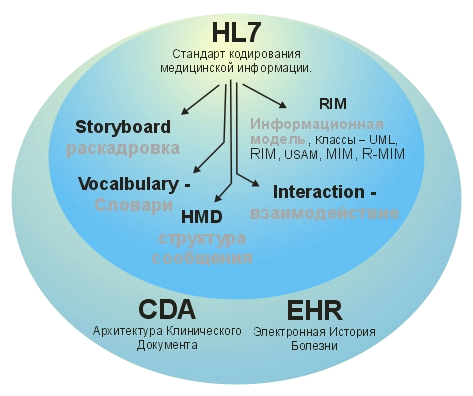Separate medical data storage and regional information systems

A couple of months ago we wrote about the issue of storing the results of medical diagnostics . Let's continue the discussion of this topic and talk about the need for a separate (product independent) storage of medical data, and regional information systems.
Obviously, the task of storing medical data — case histories, patient examinations — is complicated by several aspects:
- legal value of information
- large volume (the results of tomography can "weigh" a few gigabytes),
- heterogeneity
- complex data structure.
The computerization of health care and the introduction of information systems have revealed the need to develop a standard for a medical data transmission protocol. This is how HL7 , the standard of data exchange and data management within the computer networks of medical institutions, was born.
')

Examination and treatment of patients involves the generation of not only textual information, but also visual, and in considerable amounts - X-rays, the results of ultrasound and tomographic studies. And in connection with the development of medical technology, its wide penetration and increase in resolution, the volume of visual data is growing every year. Therefore, even in the 1980s, the DICOM (Digital Imaging and Communications in Medicine) industry standard was developed, which is used in all kinds of medical equipment. It formalizes the creation, storage, transmission and visualization of the above-described images and various documents.
Over time, new versions of standards appeared, medical information systems developed and became more complex, and computerization was actively penetrating medicine. And despite the existence of standards designed to streamline work with data, compatibility problems between equipment and information systems arose in such a complex ecosystem, and the integration process proved to be very difficult. As a result, IHE (Integrating the Healthcare Enterprise) international organization created a system of standards (concept) for cataloging the exchange of medical data between organizations and information systems - XDS (Cross-Enterprise Document Sharing). Within this concept, IHE develops various integration profiles, structured by specializations and patient care processes.
One of the important consequences of the development of all these standards was the fact that in the health sector there was a fertile situation for abandoning the product-dependent data storage model, both structured and unstructured (document scans, voice recordings, etc.). Nothing lasts forever, information systems and equipment change, but this does not affect the data itself. Now they can now be stored separately, and at the end of the life cycle of the system, it will not be necessary to deal with the expensive and time-consuming transfer of the accumulated data to the new system. In addition, separate standardized storage allows you to create universal databases that are available for any medical systems. This saves on storage infrastructure and speeds up and simplifies obtaining the necessary medical information for each patient from anywhere in the country, and even the world. Not to mention that even within the framework of one institution several heterogeneous systems can be used simultaneously, operating with a single information repository.
Today, this approach is increasingly being introduced in the health care of many countries, including in Russia. We live in an era when the management of huge amounts of information can bring the government considerable dividends . Caring for the health of the nation and freedom of migration imply, among other things, the creation of a federal EGIS (Unified State Information System) aggregating medical data for each resident. This large-scale task is solved in stages, by introducing regional systems into which information from medical institutions will flow.
The regional segment should ensure the transparent delivery of information for the Integrated Electronic Medical Record, improve the manageability of regional healthcare institutions and provide analysis and forecasting of resource utilization, treatment costs, diseases and epidemiological situation. Therefore, regional systems will also perform the task of final unification of data, bringing them to strict compliance with standards. Indeed, despite the above described HL7, DICOM and XDS, various information systems used in institutions can quite freely handle the standards, distorting them and introducing unnecessary elements.
EMC HIP
To address the multiple challenges faced by developers of unified information systems at the regional and federal levels, the EMC has developed an architectural approach to the Healthcare Integration Portfolio (HIP) certified by IHE for compliance with the main integration profiles.
EMC HIP consists of integrated modules, each of which allows to solve specific tasks assigned to regions by the Ministry of Health and Social Development.
The top level of the HIP architecture is based on the concept of XDS. It involves the creation of repositories and image controllers, both scattered throughout the region and placed compactly.

The independence of the stored information from the storage hardware allows transparently migrating data, flexibly changing the physical storage infrastructure. The platform provides hundreds of thousands of users with stored information of more than 1 billion documents.
Connection to the federal services of the Integrated Electronic Medical Record (IEMC) is provided using the integration profile XDS.b. A regional segment can be built using both its own register of documents and the registry of the federal level.
Source: https://habr.com/ru/post/273019/
All Articles